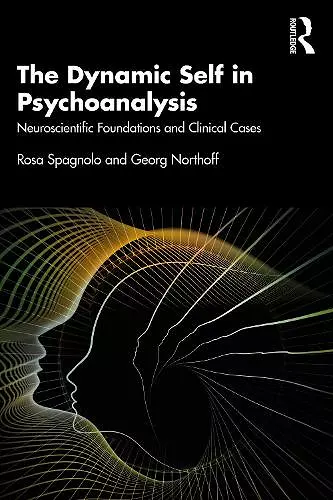The Dynamic Self in Psychoanalysis
Neuroscientific Foundations and Clinical Cases
Georg Northoff author Rosa Spagnolo author
Format:Paperback
Publisher:Taylor & Francis Ltd
Published:28th Oct '21
Should be back in stock very soon
This paperback is available in another edition too:
- Hardback£120.00(9781032114392)

The Dynamic Self in Psychoanalysisbuilds a bridge between two different but intertwined disciplines—psychoanalysis and neuroscience—by examining the Self and its dynamics at the psychological and neuronal level.
Rosa Spagnolo and Georg Northoff seek continuity in the relationship between psychoanalysis and neuroscience, emphasizing how both inform psychotherapy and psychoanalytic treatment and exploring the transformations of the Self that occur during this work. Each chapter presents clinical examples which demonstrate the evolution of the spatiotemporal and affective dimensions of the Self in a variety of psychopathologies. Spagnolo and Northoff analyze the possible use of new neuroscientific findings to improve clinical treatment in psychodynamic therapy and present a spatio-temporal approach that has significant implications for the practice of psychotherapy and for future research.
The Dynamic Self in Psychoanalysiswill be of great interest to psychoanalysts, psychotherapists, neuroscientists and neuropsychiatrists.
"This book concerns a fundamental topic in mental science: the nature of the self. The authors bring an incredible range and depth of expertise to it. Spagnolo is a psychoanalyst and paediatric neurologist; Northoff is a neuroscientist, psychiatrist and philosopher. The result is an intellectual banquet of clinical descriptions, science and philosophy, with extremely rich theorizing."
Mark Solms, Research Chair of the International Psychoanalytical Association, Co-Chair of the International Neuropsychoanalysis Society
"The case of psychoanalysis remains a puzzle. You can look at it as a form of treatment, or as a scientific approach to the study of the mind, or as a philosophical topic. But you always find the same mixed response: on the one hand, you encounter great success, a large following, and a multitude of sensation seekers; on the other hand, you find the critics and the controversy.
The death of psychoanalysis has been announced and postponed but it never took place. Ironically, in spite of no death, there already is a revival of psychoanalysis. The branch of it that carries the day concerns the natural marriage of psychoanalysis and neuroscience which began with the work of Mark Solms and has only gained in strength. To this setting, come Rosa Spagnolo and Georg Northoff with a welcome addition to the pertinent literature. They aim at explaining each side of the partnership to the other side and their effort will reward the intellectually curious and the practical minded alike. I wish them great success."
Antonio Damasio, author, The Strange Order of Things; Dornsife Professor of Neuroscience, Psychology & Philosophy, and Director, Brain and Creativity Institute, University of Southern California, Los Angeles, USA
"Is it possible to build a bridge between two different, but intertwined, disciplines such as psychoanalysis and neuroscience? What is the glue that aligns together the different elements of this bridge? For Rosa Spagnolo and Georg Northoff, the Self, and its dynamic at psychological and neuronal level, might be the candidate.
Several psychoanalysts like Jung, Kohut, Winnicott, Modell, Bromberg, and neuroscientists like Northoff, Panksepp, Damasio, Solms and Schore, just to name a few, tried to define the intrinsic sense of subjectivity that characterize our psyche. The Self is shaped by the alignment with the world where the intra/inter-psychic structure is nurtured by a good enough interaction with the animate environment.
In this book, departing from the building blocks represented by time and space, moving through the relation with the body, the other, the world and finally to the dreams, the Self is disentangled in its own dynamic features.
The continuous integration of the spatio-temporal approach with psychodynamic processes behind the transformation of the Self is highly innovative and sheds a novel perspective on the case histories reported.
Wisely describing clinical experiences, The Dynamic Self aims at looking for the continuity in the relation between psychoanalysis and neuroscience, emphasizing how they might be two sides of a coin informing psychotherapy and psychoanalytic treatment. The spatio-temporal approach will have huge implications for psychotherapy and future research."
Andrea Scalabrini, PhD, PsyD; Neuroscientist and Psychotherapist-Psychoanalyst; Post-doc researcher at University G. d’Annunzio of Chieti-Pescara, Italy
ISBN: 9780367428969
Dimensions: unknown
Weight: 231g
142 pages